Assessment of Long-Term Watershed Management on Reservoir Phosphorus Concentrations and Export Fluxes
Abstract
1. Introduction
2. Materials and Methods
2.1. Study Area and Data Collection
2.2. Anthropogenic P Calculation
2.3. Phosphorus Export Flux Estimation
3. Results and Discussion
3.1. Long-Term Changes of Reservoir TP Concentration and Flux
3.2. Long-Term Changes in Watershed Anthropogenic P Sources
3.3. Response of Reservoir TP Concentration and Flux to Watershed Anthropogenic P Inputs
3.4. Recommendation for Watershed P Management
4. Conclusions
Author Contributions
Funding
Acknowledgments
Conflicts of Interest
References
- Han, H.; Bosch, N.; Allan, J.D. Spatial and temporal variation in phosphorus budgets for 24 watersheds in the Lake Erie and Lake Michigan basins. Biogeochemistry 2010, 102, 45–58. [Google Scholar] [CrossRef]
- Chen, D.J.; Hu, M.P.; Guo, Y.; Wang, J.H.; Huang, H.; Dahlgren, R.A. Long-term (1980–2010) changes in cropland phosphorus budgets, use efficiency and legacy pools across townships in the Yongan watershed, eastern China. Agr. Ecosyst. Environ. 2017, 236, 166–176. [Google Scholar] [CrossRef]
- State Statistics Bureau. China Statistical Yearbook 2016; China Statistics Press: Beijing, China, 2016. [Google Scholar]
- Han, Y.G.; Yu, X.X.; Wang, X.X.; Wang, Y.Q.; Tian, J.X.; Xu, L.; Wang, C.Z. Net anthropogenic phosphorus inputs (NAPI) index application in mainland China. Chemosphere 2013, 90, 329–337. [Google Scholar] [CrossRef] [PubMed]
- Drewry, J.J.; Newham, L.T.; Croke, B.F. Suspended sediment, nitrogen and phosphorus concentrations and exports during storm—Events to the Tuross estuary, Australia. J. Environ. Manag. 2009, 90, 879–887. [Google Scholar] [CrossRef] [PubMed]
- Paerl, H.; Xu, H.; Hall, N.S.; Rossignol, K.L.; Joyner, A.R.; Zhu, G.W.; Qin, B.Q. Nutrient limitation dynamics examined on a multi-annual scale in Lake Taihu, China: Implications for controlling eutrophication and harmful algal blooms. J. Fresh. Ecol. 2015, 30, 5–24. [Google Scholar] [CrossRef]
- Wang, C.; Bai, L.; Jiang, H.L.; Xu, H. Algal bloom sedimentation induces variable control of lake eutrophication by phosphorus inactivating agents. Sci. Total Environ. 2016, 557–558, 479–488. [Google Scholar] [CrossRef] [PubMed]
- Christensen, V.G.; Maki, R.P.; Liesling, R.L. Evaluation of internal loading and water level changes: Implications for phosphorus, algal production, and nuisance blooms in Kabetogama Lake, Voyageurs National Park, Minnesota. Lake. Reserv. Manag. 2013, 29, 202–215. [Google Scholar] [CrossRef]
- Holas, J.; Holas, M.; Chour, V. Pollution by phosphorus and nitrogen in water streams feeding the Zelivka drinking water reservoir. Water Sci. Tech. 1999, 39, 207–214. [Google Scholar] [CrossRef]
- Moore, B.C.; Christensen, D. Newman Lake restoration: A case study. Part I. Chemical and biological responses to phosphorus control. Lake Reserv. Manag. 2009, 25, 337–350. [Google Scholar] [CrossRef]
- Schindler, D.W.; Carpenter, S.R.; Chapra, S.C.; Hecky, R.E.; Orihel, D.M. Reducing phosphorus to curb lake eutrophication is a success. Environ. Sci. Tech. 2016, 50, 8923–8929. [Google Scholar] [CrossRef] [PubMed]
- Povilaitis, A. Phosphorus trends in Lithuanian Rivers affected by agricultural non-point pollution. Environ. Res. Eng. Manag. 2004, 4, 17–27. [Google Scholar]
- Meals, D.W.; Dressing, S.A.; Davenport, T.E. Lag time in water quality response to best management practices: A review. J. Environ. Qual. 2009, 39, 85–97. [Google Scholar] [CrossRef] [PubMed]
- Sharpley, A.N.; Jarvie, H.P.; Buda, A.; May, L.; Kleinman, P. Phosphorus legacy: Overcoming the effects of past management practices to mitigate future water quality impairment. J. Environ. Qual. 2013, 42, 1308–1326. [Google Scholar] [CrossRef] [PubMed]
- Gburek, W.J.; Sharpley, A.N.; Heathwaite, L.; Folmar, G.J. Phosphorus management at the watershed scale: A modification of the phosphorus index. J. Environ. Qual. 2000, 29, 130–144. [Google Scholar] [CrossRef]
- Lin, X.S.; Tang, J.; Li, Z.Y.; Li, H.Y. Finite element simulation of total nitrogen transport in riparian buffer in an agricultural watershed. Sustainability 2016, 8, 288. [Google Scholar] [CrossRef]
- van Lier, J.B. High-rate anaerobic wastewater treatment: Diversifying from end-of-the-pipe treatment to resource-oriented conversion techniques. Water Sci. Technol. 2008, 57, 1137–1148. [Google Scholar] [CrossRef] [PubMed]
- Zhang, W.S.; Swaney, D.P.; Li, X.Y.; Hong, B.; Howarth, R.W.; Ding, S.H. Anthropogenic point-source and non-point-source nitrogen inputs into Huai River basin and their impacts on riverine ammonia–nitrogen flux. Biogeosciences 2015, 12, 4275–4289. [Google Scholar] [CrossRef]
- Gorgoglione, A.; Bombardelli, F.A.; Pitton, B.J.L.; Oki, L.R.; Haver, D.L.; Young, T.M. Role of sediments in insecticide runoff from urban surfaces: Analysis and modeling. Int. J. Environ. Res. Public Health 2018, 15, 1464. [Google Scholar] [CrossRef] [PubMed]
- Huang, H.; Chen, D.J.; Zhang, B.F.; Zeng, L.Z.; Dahlgren, R.A. Modeling and forecasting riverine dissolved inorganic nitrogen export using anthropogenic nitrogen inputs, hydroclimate, and land–use change. J. Hydrol. 2014, 517, 95–104. [Google Scholar] [CrossRef]
- Chen, D.J.; Hu, M.P.; Guo, Y.; Dahlgren, R.A. Influence of legacy phosphorus, land use, and climate change on anthropogenic phosphorus inputs and riverine export dynamics. Biogeochemistry 2015, 123, 99–116. [Google Scholar] [CrossRef]
- Dong, X.; Mei, K.; Shang, X.; Huang, S.H.; Huang, H. Analysis of variation trend of water quality based on Mann-Kendall Test and rescaled range analysis. J. Eco. Rural Environ. 2016, 32, 277–282. [Google Scholar] [CrossRef]
- Zhang, W.Q.; Jin, X.; Liu, D.; Lang, C.; Shan, B.Q. Temporal and spatial variation of nitrogen and phosphorus and eutrophication assessment for a typical arid river—Fuyang River in northern China. J. Environ. Sci. 2017, 55, 41–48. [Google Scholar] [CrossRef] [PubMed]
- Mei, K.; Shang, X.; Wang, Z.F.; Huang, S.H.; Dong, X.; Huang, H. Influence of land use on memory effect of watershed nitrogen. J. Environ. Sci. 2016, 36, 3856–3863. [Google Scholar] [CrossRef]
- Huang, H.; Wang, Z.F.; Xia, F.; Shang, X.; Liu, Y.Y.; Zhang, M.H.; Dahlgren, R.A.; Mei, K. Water quality trend and change—Point analyses using integration of locally weighted polynomial regression and segmented regression. Environ. Sci. Pollut. Res. 2017, 24, 15827–15837. [Google Scholar] [CrossRef] [PubMed]
- State Environmental Protection Administration. Water and Wastewater Monitoring and Analysis Method, 4th ed.; China Environmental Science Press: Beijing, China, 2002. [Google Scholar]
- Chen, D.J.; Hu, M.P.; Wang, J.; Guo, Y.; Dahlgren, R.A. Factors controlling phosphorus export from agricultural/forest and residential systems to rivers in eastern China, 1980–2011. J. Hydrol. 2016, 533, 53–61. [Google Scholar] [CrossRef]
- Borbor-Cordova, M.J.; Boyer, E.W.; McDowell, W.H.; Hal, C.A. Nitrogen and phosphorus budgets for a tropical watershed impacted by agricultural land use: Guayas, Ecuador. Biogeochemistry 2006, 79, 135–161. [Google Scholar] [CrossRef]
- Russell, M.J.; Weller, D.E.; Jordan, T.E.; Sigwart, K.J.; Sullivan, K.J. Net anthropogenic phosphorus inputs: Spatial and temporal variability in the Chesapeake Bay region. Biogeochemistry 2008, 88, 285–304. [Google Scholar] [CrossRef]
- Sobota, D.J.; Harrison, J.A.; Dahlgren, R.A. Linking dissolved and particulate phosphorus export in rivers draining California’s Central Valley with anthropogenic sources at the regional scale. J. Environ. Qual. 2011, 40, 1290–1302. [Google Scholar] [CrossRef] [PubMed]
- Zhang, W.S.; Swaney, D.P.; Hong, B.; Howarth, R.W. Anthropogenic phosphorus inputs to a river basin and their impacts on phosphorus fluxes along its upstream-downstream continuum. J. Geophys. Res. Biogeosci. 2017, 122, 3273–3287. [Google Scholar] [CrossRef]
- Meng, C.; Wang, Y.; Li, Y.; Zhou, J.G.; Li, Y.; Wu, J.S. Deteriorated water quality of agricultural catchments in South China by net anthropogenic phosphorus inputs. Sustainability 2017, 9, 1480. [Google Scholar] [CrossRef]
- Huang, H.; Lu, J. Identification of river water pollution characteristics based on projection pursuit and factor analysis. Environ. Earth Sci. 2014, 72, 3409–3417. [Google Scholar] [CrossRef]
- Huang, H.; Zhang, B.F.; Lu, J. Quantitative identification of riverine nitrogen from point, direct runoff and base flow sources. Water Sci. Tech. 2014, 70, 865–870. [Google Scholar] [CrossRef] [PubMed]
- Zhong, L.J.; Mol, A.P.J.; Fu, T. Public–private partnerships in China’s urban water sector. Environ. Manage. 2008, 41, 863–877. [Google Scholar] [CrossRef] [PubMed]
- Zheng, S.; Tiong, R.L.K. First public–Private–Partnership application in Taiwan’s wastewater treatment sector: Case study of the Nanzih BOT wastewater treatment project. J. Constr. Eng. Manag. 2010, 136, 913–922. [Google Scholar] [CrossRef]
- Lee, C.H.; Yu, Y.H. Characteristics of public–private partnerships for municipal wastewater treatment in Taiwan. J. Chin. Inst. Eng. 2012, 35, 245–258. [Google Scholar] [CrossRef]
- Ke, Y.J.; Wang, S.Q.; Chan, A.P.C.; Lam, P.T.I. Preferred risk allocation in China’s public–private partnership (PPP) projects. Int. J. Proj. Manag. 2010, 28, 482–492. [Google Scholar] [CrossRef]
- Gao, L.; Wang, W.; Bai, Y.L.; Wu, L. A case study on steel industry: Study on integrated outsourcing operation of Environmental Projection Facilities. Resour. Ind. 2015, 17, 51–55. [Google Scholar] [CrossRef]
- Ruan, B.Q.; Xu, F.R.; Zhang, C.L. Review of research and practice of river basin ecological compensation. J. Hydraul. Eng. 2008, 39, 1220–1225. [Google Scholar]
- Ye, L.L.; Zhu, Y.; Xu, S.Y. Effect of microbe on stability of bioavailable phosphorus in sediment of Chaohu Lake. Resour. Environ. Eng. 2007, 31, 339–343. [Google Scholar] [CrossRef]
- Hupfer, M.; Lewandowski, J. Oxygen controls the phosphorus release from lake sediments–a long–lasting paradigm in limnology–review paper. Int. Rev. Hydrobiol. 2008, 93, 415–432. [Google Scholar] [CrossRef]
- Xu, Y.; Chen, J.A.; Wang, J.; Luo, J. The micro-scale investigation on the effect of redox condition on the release of the sediment phosphorus in Lake Hongfeng. J. Lake Sci. 2016, 28, 68–74. [Google Scholar] [CrossRef]
- Ren, K.; Mei, K.; Zhu, H.M.; He, R.; Zhu, Y.L.; Lu, P.; Zhang, M.H. Quantitative estimation of soil erosion in Shanxi Reservoir basin based on RUSLE. Chin. J. Ecol. 2015, 34, 1950–1958. [Google Scholar]
- Kumar, S.; Mishra, A. Critical erosion area identification based on hydrological response unit level for effective sedimentation control in a river basin. Water Resour. Manag. 2015, 29, 1–17. [Google Scholar] [CrossRef]
- Drewry, J.J.; Newham, L.T.H.; Greene, R.S.B. Index models to evaluate the risk of phosphorus and nitrogen loss at catchment scales. J. Environ. Manag. 2011, 92, 639–649. [Google Scholar] [CrossRef] [PubMed]
- Zhou, Z.C.; Shangguan, Z.P.; Zhao, D. Modeling vegetation coverage and soil erosion in the loess plateau area of China. Eco. Model. 2006, 198, 263–268. [Google Scholar] [CrossRef]
- Huang, X.; Liu, Y.; Li, J.; Xiong, X.; Yin, X.; Feng, D. The response of mulberry trees after seedling hardening to summer drought in the hydro–fluctuation belt of Three Gorges Reservoir Areas. Environ. Sci. Pollut. Res. 2013, 20, 7103–7111. [Google Scholar] [CrossRef] [PubMed]
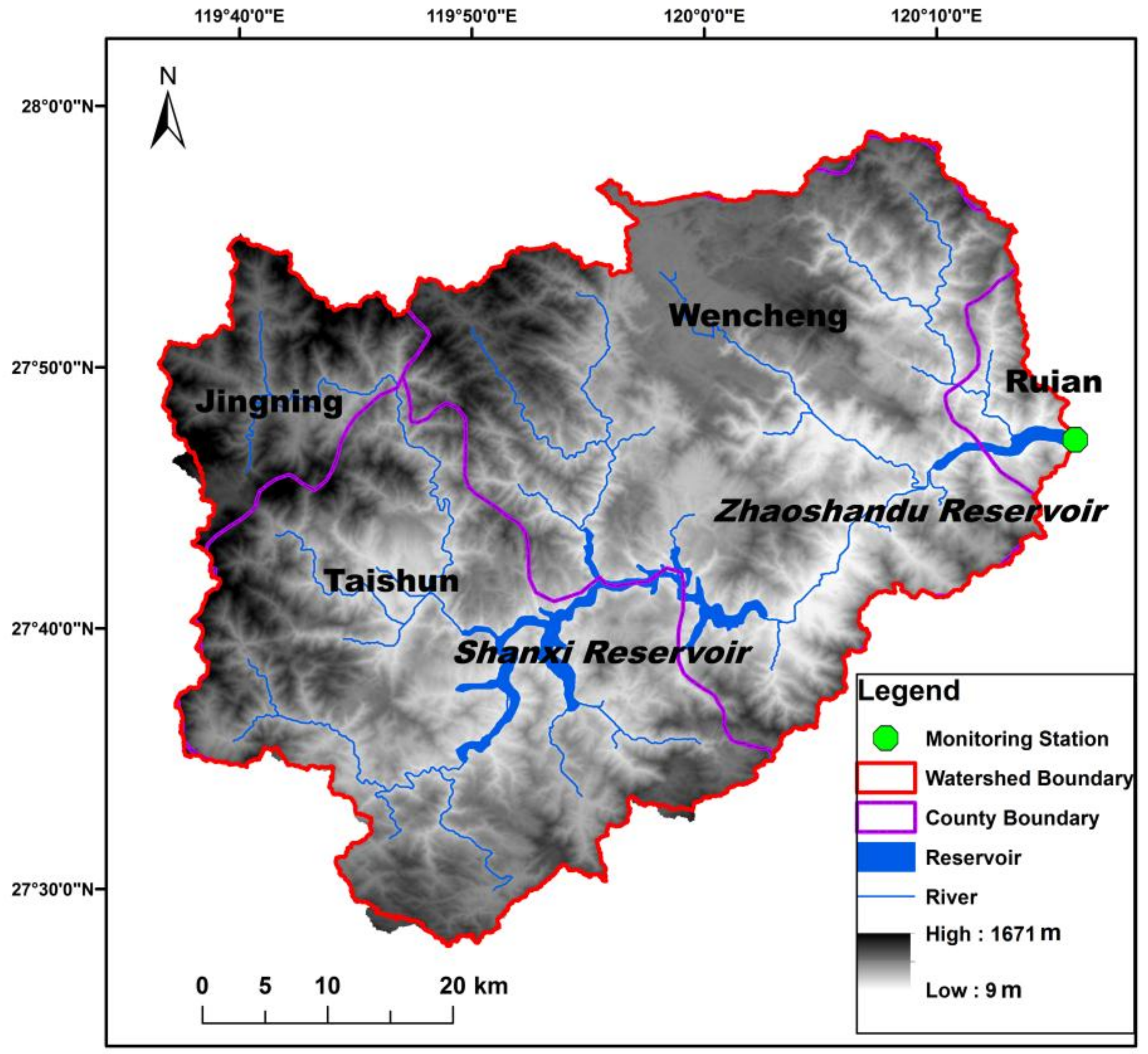
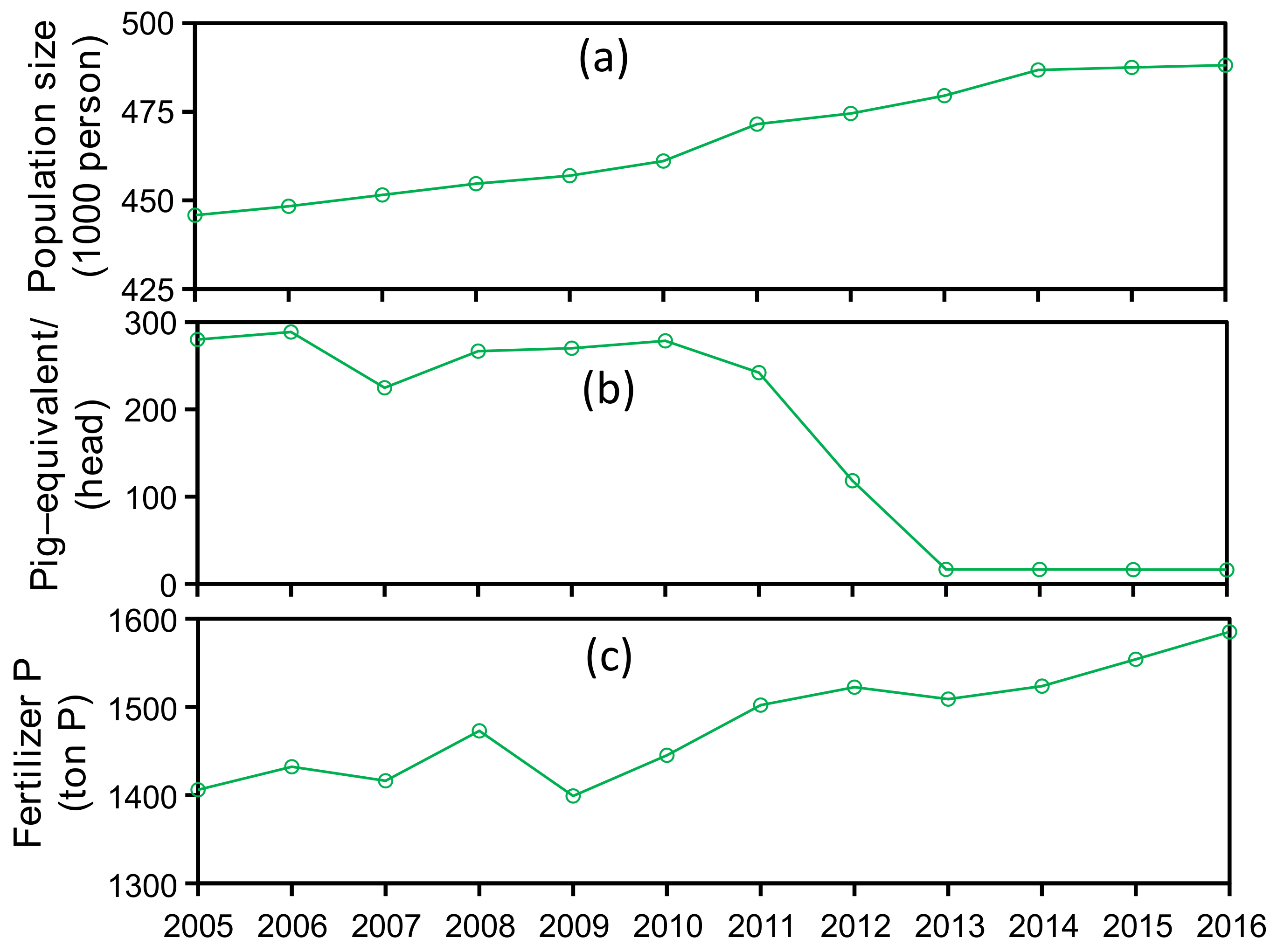
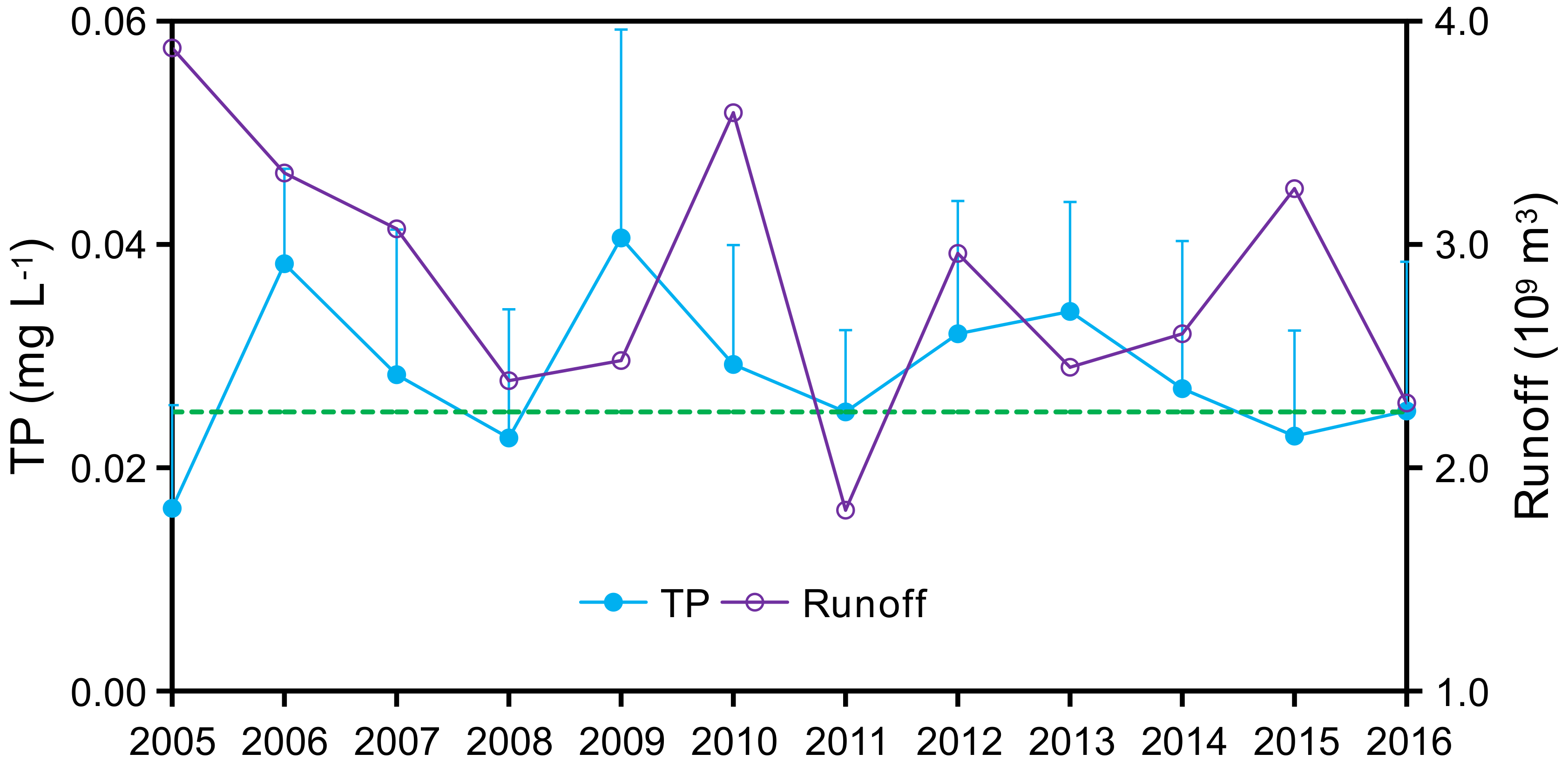

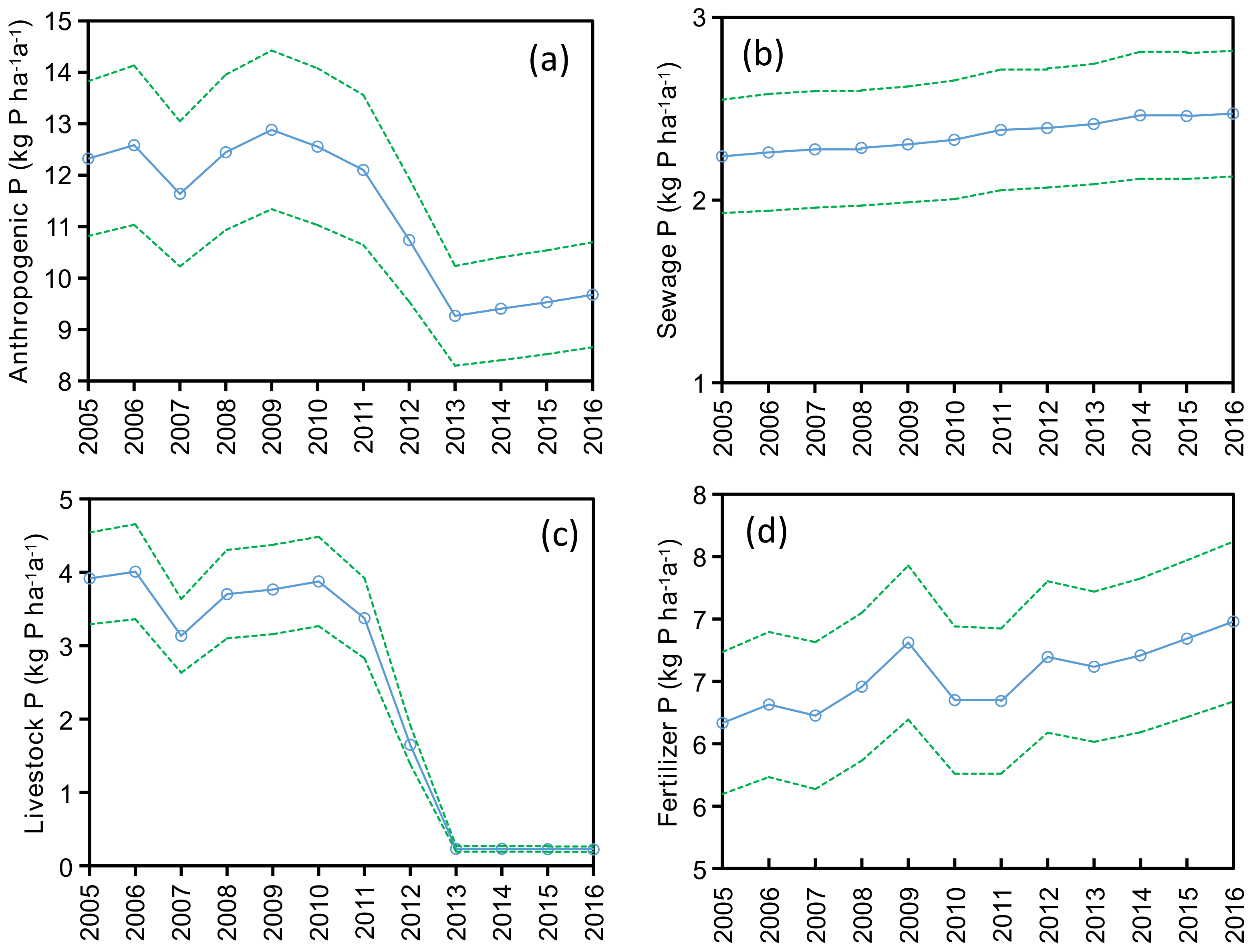
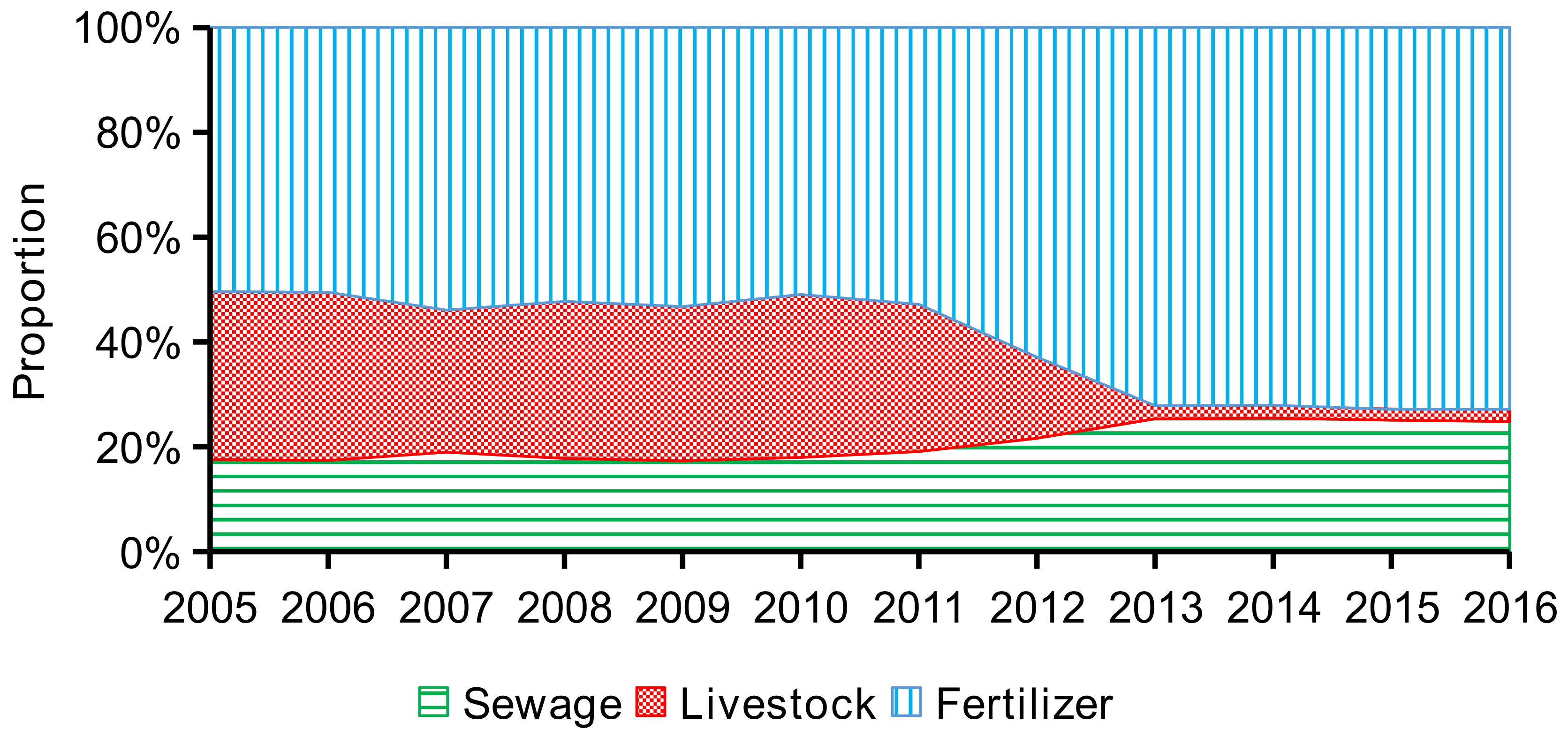
| Parameter | Human Excretion | Human Detergent | Pig Excretion |
|---|---|---|---|
| Estimated value | 0.52 kg P/(person·a) | 0.62 kg P/(person·a) | 3.17 kg P/(animal·a) |
| Grade | I | II | III | IV | V |
|---|---|---|---|---|---|
| TP (mg/L) | ≤0.01 | ≤0.025 | ≤0.05 | ≤0.1 | ≤0.2 |
| Percentage/% | Watershed | Reference |
|---|---|---|
| 11.9–61.1 | Guayas River, Ecuador | [28] |
| 0.66–8.65 | Chesapeake Bay, USA | [29] |
| 3.6–5.4 | Lake Michigan, USA | [1] |
| 5.6–25.3 | Lake Erie, USA | [1] |
| 2.0–72.0 | Central Valley, California, USA | [30] |
| 1.6–14.2 | Yongan River, China | [21] |
| 1.5–19.2 | Huai River, China | [18] |
| 2.0–9.0 | Hongze Lake, Zhejiang, China | [31] |
| 2.3–7.9 | Jingning Region, Hunan, China | [32] |
© 2018 by the authors. Licensee MDPI, Basel, Switzerland. This article is an open access article distributed under the terms and conditions of the Creative Commons Attribution (CC BY) license (http://creativecommons.org/licenses/by/4.0/).
Share and Cite
Huang, X.; Chen, H.; Xia, F.; Wang, Z.; Mei, K.; Shang, X.; Liu, Y.; Dahlgren, R.A.; Zhang, M.; Huang, H. Assessment of Long-Term Watershed Management on Reservoir Phosphorus Concentrations and Export Fluxes. Int. J. Environ. Res. Public Health 2018, 15, 2169. https://doi.org/10.3390/ijerph15102169
Huang X, Chen H, Xia F, Wang Z, Mei K, Shang X, Liu Y, Dahlgren RA, Zhang M, Huang H. Assessment of Long-Term Watershed Management on Reservoir Phosphorus Concentrations and Export Fluxes. International Journal of Environmental Research and Public Health. 2018; 15(10):2169. https://doi.org/10.3390/ijerph15102169
Chicago/Turabian StyleHuang, Xiaolin, Han Chen, Fang Xia, Zhenfeng Wang, Kun Mei, Xu Shang, Yuanyuan Liu, Randy A. Dahlgren, Minghua Zhang, and Hong Huang. 2018. "Assessment of Long-Term Watershed Management on Reservoir Phosphorus Concentrations and Export Fluxes" International Journal of Environmental Research and Public Health 15, no. 10: 2169. https://doi.org/10.3390/ijerph15102169
APA StyleHuang, X., Chen, H., Xia, F., Wang, Z., Mei, K., Shang, X., Liu, Y., Dahlgren, R. A., Zhang, M., & Huang, H. (2018). Assessment of Long-Term Watershed Management on Reservoir Phosphorus Concentrations and Export Fluxes. International Journal of Environmental Research and Public Health, 15(10), 2169. https://doi.org/10.3390/ijerph15102169





